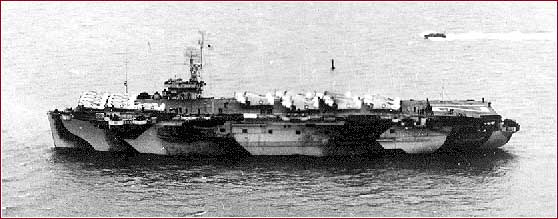|
The woman who wrote the letters was Margaret H. Warren. Her husband, Roland L. Warren, survived when his ship went down in the Atlantic on May 29, 1944. The USS Block Island, a small aircraft carrier, was on anti-submarine duty with its three air squadrons and four destroyer escorts. It took three torpedoes and stayed afloat long enough for the surviving crew to hit the water and swim or paddle to two of the destroyers.
After this came a month's survivors leave at home and then orders to report to Seattle, Washington in ten days. He and his wife and their two infant children drove to the West Coast and spent several months there while the new carrier, also named the Block Island, was put in commission. They lived in Tacoma during that time. After that, they went down to San Diego, and soon, as the new ship put to sea, Margaret (Peg) returned with the children back home to Alfred, New York, driving across the country in the family's old 1936 Plymouth in the middle of winter. The letters began. Roland was visual signal officer on the new Block Island which traversed the Pacific first from Pearl Harbor to Ulithi Atoll, then to the Philippines, then Guam and Saipan, Okinawa, Formosa, Borneo, then back to the Philippines and up to Guam and Saipan. Roland was in Saipan when the first atom bomb was exploded over Hiroshima on August 6, 1945 (August 7 at Saipan).Whatever one might think of the basic morality or immorality of that bombing, it is hard to describe Roland's joy at learning of it and learning that he therefore would not have to risk being one of the anticipated million casualties in invading Japan. His own feeling later was that the bomb was little worse than the more conventional bombing of Tokyo or Dresden, each of which suffered the same approximate number of innocent civilian casualties, but that the bomb, and the second one two days later, should have been dropped on an unpopulated place and the Japanese simply have been told to "go see." Roland finally stepped off the train at Hornell, New York a few days before Christmas the same year of 1945, and that was a homecoming to remember! Meanwhile, the letters kept coming. How many men in the World War II armed forces were privileged to receive letters like this in content and in quality from their wives? - or the equivalent of these letters, for of course there are differences in cultural preferences, in education, in life styles, and the kind of qualities that different men admire in women or desire in a mate The woman who wrote these letters was obviously a person of great strength and firm opinions. She was strict with her young children but poured the love on at every juncture. She showed great creativity in keeping them amused and in helping them learn what they needed to know. She reveled in the signs of creativity, humor, yes, and firmness in her children. She obviously idolized her husband, but on occasion showed a firm set of expectations and a resolve to be her own person. Her letters are filled with expressions of love, sometimes fairly commonplace, other times creative, romantic, and poetic. Her sense of humor pops out again and again, often surprisingly in the context of the serious events she relates. The way she starts her letters varies along a spectrum from Dear Honey (his nickname) to Dear Duckbumps. The letters portray the many aspects of life on the home front under war-time conditions: the scarcity of household items, the rationing of gasoline, tires, and many types of food such as butter and meat, the problems of raising children with their fathers abroad, the gulf between those with loved ones in the services and those without, the price of ordinary food, clothing, and furniture at that time, the social life of "war wives," now on their own, instead of part of a husband-wife team, and the increased responsibilities in household management and finances. In this woman's case, there was the additional responsibility of buying a new house, renovating it from stem to stern, and furnishing it, along with the financial problems that this entailed. No doubt there were other letters written by other war wives to their husbands which embodied in equivalent fashion the qualities a service man might hope for in his wife. Those service men are the lucky ones. As an aside, the reader may also notice how miserly the writer harbored her punctuation marks, especially commas, and how the meaning usually comes through clearly without them. Words in parentheses were in the original, but occasional words in brackets were added to indicate the context. Continue with Making Ends Meet |
